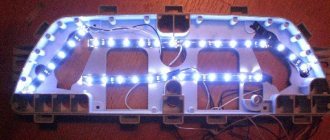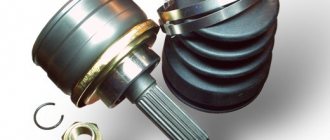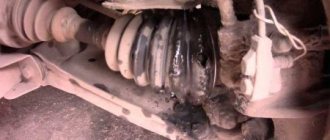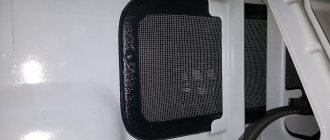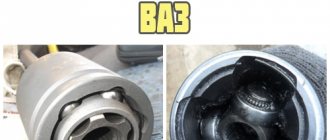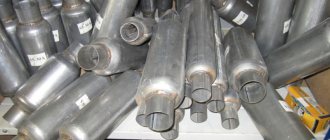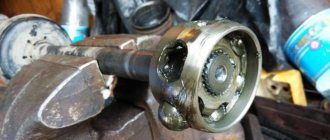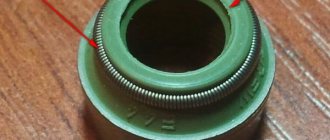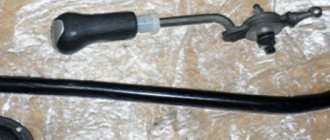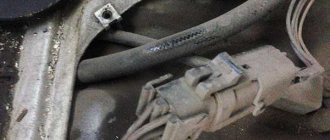Welcome! CV joint - Constant Angular Velocity Joint, thanks to it, all the moment that comes from the engine to the box is transmitted to the front wheels, this part is used exclusively in front-wheel drive cars (or all-wheel drive), but if the car is equipped with rear-wheel drive, then instead of this part they install a driveshaft, by the way, it performs the same function as a CV joint, namely, it transmits torque from the gearbox to the wheels. Because of the CV joint, they could not start producing front-wheel drive cars for a long time (in the beginning, all were rear-wheel drive), because it was difficult to implement and simply no one had invented it at that time, and therefore front-wheel drive on cars was not practiced at first.
Note! To replace the outer and inner CV joints, you will need: Firstly, you will need special pliers with which to install the protective covers on the clamps. If you don’t have such pliers and you are not going to buy them, then instead of them you can use thin sliding pliers, and also pliers, thanks to which the retaining rings you can remove it, you will need it, as well as CV joint lubricant (Be sure to stock up, don’t even start work without it, if you don’t find just such a lubricant, then look for something like it, no matter what the name is, the main thing is that it is suitable for lubrication of CV joints), a new boot will be you need (But this is if yours is torn, if your boot is in normal condition, then you don’t need to take a new one) and a new retaining ring of the inner CV joint (It is definitely needed) and thrust rings, too, and be sure to have a new hub nut!
Where are the outer and inner CV joints located? It’s easiest to see it from below the car, by the way, and you’ll have to remove it by crawling under the bottom, although you can do without it (For example, you can put planks under the front wheels and lift the front part with two jacks, provided that both jacks stand on these planks, thereby in front of will be higher, this is especially convenient if the car is tall), but it’s still better to put the car on a lift and replace the CV joint you need with a new one, but we’ll immediately explain to you what outer and inner CV joints mean so that you understand this and are no longer confused (It’s just that in the article we will often talk about them and so that you can immediately understand what kind of CV joint we are talking about), so the outer one is the one that faces the car wheel and is inserted into the hub (Both outer ones are indicated by green arrows), and the inner one is the one that is inserted into the box (They are indicated by yellow arrows) and there are four total CV joints in front-wheel drive cars, two of them are located on the left side and go to the left wheel, and the other two are on the right and go to the right wheel, but here are the drives on which CV joints Only two are installed and both of them are indicated by blue arrows in the photo.
When do you need to change the outer and inner CV joints? When it starts knocking, then it needs to be replaced, in addition, you also need to monitor the condition of its boot and from time to time look under it and see if there is grease inside the boot, whether dirt or other kinds of particles have got there, sand for example, under the boot of this There absolutely shouldn’t be anything, only one lubricant should be there. To understand in more detail how you can check the CV joint for performance, you can watch the video clip which is located just below:
How to replace the outer and inner CV joints on a VAZ 2110-VAZ 2112?
Removal: 1) It doesn’t take that long to change the CV joint, but it’s just a very painstaking job that requires not only removing the CV joint itself, but also the wheels and disconnecting the ball joint, and many other small operations will have to be done, but you will need to start first with draining oil from the box, this is done so that when you get ready to remove the CV joint, the oil does not leak out of the box, but you carefully drain it yourself (For information on how to do this, read the article: “Changing the oil in the box on a VAZ”) , then remove the crankcase protection if it is present on your car (It will just get in the way) and then unscrew the hub nut a little (It is indicated by a red arrow, but only use a screwdriver to open the collars that will not allow it to be unscrewed and also do not forget to remove the plastic cover , which closes this nut from dirt getting into it), and then remove the wheel itself from the car, but just remember which side you are going to change the CV joint, and remove the wheel from the car from that side (For information on how to remove a wheel, read in article: “Correctly replacing a wheel on a car”).
2) When you’re done with the wheel, move to the top of the car and loosen the three nuts that secure the strut to the cup (Indicated by arrows), but don’t unscrew, just loosen two or three turns (If necessary, loosen more), then unscrew completely two bolts that secure the ball joint to the steering knuckle (see small photo) and once the work is done, unscrew the hub nut completely and remove the washer located behind it (Don’t lose it, by the way, it’s very convenient to pry it off with a magnetic screwdriver), and finally Turn the steering wheel all the way to the right or left.
Note! The steering wheel must be turned to the right if you are going to remove the CV joints on the left side (Look as the car is moving), and to the left if you are going to remove and change the CV joints on the right side!
3) Next, remove the brake hose (Be careful not to stretch it too much, otherwise it will break) from the bracket on the rack (see small photo below) and carefully pull out the part of the rack as shown in the large picture, At the same time, also remove the splined part of the outer CV joint (indicated by the red arrow) from the hole in the hub, pulling, as we have already said for this, part of the strut (it is most convenient to pull it by the brake disc, it is indicated by the blue arrow) towards you and lower the outer joint in such a way, so that it lies on the lever and no longer enters the hole in which it was previously located.
4) As soon as the splined part of the outer CV joint is removed from the hub, remove the inner part in exactly the same way, but although it is not even approximately removed in the same way, in general, to remove the inner part from the hole in the gearbox into which it fits, take a mounting blade , a thick chisel or something similar and insert it (the chisel is indicated by a blue arrow for clarity) between the inner CV joint and the box, thereby using the mounting blade or chisel as a lever, ensure that the splined part of the inner joint comes out of the hole in the box, but only be careful not to damage the oil seal, otherwise you will have to replace it with a new one, although if you want, inspect the oil seal just in case; if possible, if it is deformed (if there is a new one nearby), replace it with a new one.
Note! Remove the drive (this is the correct name for a design with two CV joints) through the bottom of the car in the inspection ditch, as shown in the photo below:
Installation: 1. The drive is installed in the reverse order of removal; if necessary, the outer and inner CV joints are removed from it and replaced separately with new ones, but in this article we will not tell you how to do it, because on our website there is already such an article dedicated to the outer and internal CV joint, and it is called: “Repairing the wheel drive and replacing both CV joints on a car,” so if you need to replace them separately or disassemble them, for example, then study that article in detail, but we will return to the topic again and tell you how to do it installing the drive in its place, this is not so difficult to do, to do this you will first need to change the retaining ring (Indicated by the green arrow) of the inner CV joint with a new one, after replacing, apply grease to the spline (Indicated by the red arrow) and on the smooth surface of the shank (Indicated by the red arrow) blue arrow).
2. Now you can insert the shank of the inner CV joint into the box, but just be careful not to damage the oil seal and by the way, when installing the inner CV joint, make sure that the retaining ring with the gap upwards is directed, as soon as the inner CV joint is inserted, make sure that it does not fly out and that the retaining ring holds it, well, do all further work in the reverse order of removal and do not forget to replace the hub nut with a new one, because you cannot re-tighten the old one and do not forget to lock the new one by the way.
Note! We would like to add one more thing, in order to drive the inner CV joint all the way (it just happens that it goes in very hard and not all the way), you will need to hammer it through the outer one, this is done in this way, take a hammer and a wooden plank (You can replace the plank with any other object take one in which you are sure that it will not lead to deformation of the outer CV joint) and through it (in the photo, instead of a wooden plank, another object is taken, as you have already noticed) the outer CV joint is driven inwards, thereby the inner one enters the gearbox all the way, but Just don't overdo it and don't deform the box!
How to diagnose a problem
It is clear that there are no problems diagnosing obvious faults. But what to do if there are no visible faults, the machine is working normally, although in fact minor, insignificant damage that can lead to expensive repairs has already appeared? There are two main effective methods for determining a malfunction:
- Listen to the car while driving. If you think you have heard unusual noises, do the following: stop, move the gearshift lever into first or forward gear (depending on the type of transmission), then turn the steering wheel as far as possible in either direction. Next, take off sharply, pressing the gas pedal fully. If during such a maneuver you hear crackling or clicking sounds from the front of the car, check the condition of the CV joints.
- Options for visual diagnosis of faults include a careful external inspection of the condition of the anthers. If, when looking at the wheel rims (this will be especially noticeable on alloy wheels, since stamped ones make it difficult to see), you see traces of thick grease on the front ones, it means that the boot is torn and urgent intervention is required. If there are no traces of lubricant on the discs, then carefully inspect the boot itself. Any defects on it mean the possibility of dust, dirt and water getting inside the hinge. Therefore, make sure that there are no scratches or cracks on the boot itself, as well as that the clamps are securely tightened (the most common cause of contamination and lubricant leakage from the boot).
Replacing the CV joint and outer boot on a VAZ 2110 with your own hands (video)
The CV joint is a constant velocity joint. People simply call it a grenade. This is due to the appearance of the device. Its task is to transmit rotational motion from one axle shaft to another, and they are at a constantly changing angle in relation to one another.
This element is always under load, which is why its failure is rather a matter of time. This is even despite the fact that high-quality carbon steel is used in the production of CV joints, which can withstand severe regular loads over a long period of time.
But the grenade on the VAZ 2110 still fails. The main reasons are pollution, sand that gets inside the structure, loss of lubrication, damage to elements, torn rubber boots.
Kinds
In a VAZ 2110 car, the CV joint may need to be replaced. But which one exactly? After all, in the “ten” there are two of them - internal and external. They are necessary in order to effectively overcome all obstacles. Here one CV joint will clearly not be enough.
Internal and external
- The first grenade is internal, and it transmits torque to the shaft from the transmission.
- The second grenade is external and engages with the car's wheel hub.
Despite the fact that their operating principle is the same, they differ in design and price.
"Grenade" defects
Before replacing CV joints on a VAZ 2110, you need to make sure that they are made with high quality and can effectively perform their job in a new place.
Alas, sometimes replacing the inner CV joint on a VAZ 2110 does not give the expected result, since product defects appear during manufacturing or installation.
The literature indicates that CV joints are made from special high-strength alloys that practically do not wear out. But in practice everything looks a little different. Whatever one may say, there are no eternal parts, and CV joints are no exception.
Defects may be as follows:
- Low quality of alloys used in manufacturing;
- Banal fakes and defective components;
- Poor quality or complete lack of lubricant, which leads to rapid failure of even a new grenade;
- Damaged anthers, due to which all kinds of debris get into the grenade.
Regarding the replacement of CV joint boots on a VAZ 2110, we recommend watching a video that will help you cope with the problem that has arisen. This issue should be approached thoroughly.
Diagnose part problems
The grenades are protected by a rubber boot. It is mounted on an external and internal hinge. The boot prevents dirt from getting into the CV joint. Another of its functions is to retain lubricant; without it, the hinge will not work.
If the boot wears out over time or is torn, sand, small stones and dirt will begin to get into the joint. After some time, the CV joint will become unusable and the grenade will have to be replaced. Such repairs will cost much more
Therefore, it is important to monitor the integrity of the anther. If a defect is detected, replace the CV joint boot
You can visually check the condition of the anthers yourself, without resorting to the services of service station workers. It is best to drive your car into the inspection hole
First of all, you should pay attention to the boot of the outer CV joint. VAZ 2110 has two boots on each outer side of the wheels
These anthers most often fail. The inner boot needs to be replaced much less frequently than the outer boot.
You can check the integrity of the outer CV joint boot without a hole. We stop the VAZ 2110 on the road, preferably in a place where the car will not interfere with the movement of either cars or pedestrians. We turn the steering wheel to the right to the extreme position, this will be enough to diagnose the outer boot on the left side.
We similarly inspect the boot from the opposite side. If traces of grease are visible on the boot or there are cracks and cuts, then the boot should be replaced. The design of the VAZ 2110 allows you to cope with the replacement yourself.
Following the recommendations of experienced craftsmen, you should replace the boots of both the outer and inner CV joints at the same time. Even if the inner CV boot still looks intact and without cracks.
Functionality check
The condition of the inner and outer CV joints should be examined separately, since the procedures and symptoms are somewhat different.
External grenade
The most obvious and main sign of wear of this element is the appearance of a sound similar to a crunch. It appears because the grooves have worn out and the balls do not move along them as well as before. The crunching becomes noticeable when entering turns, sharply pressing the gas pedal or passing difficult road sections.
Grenade
If you want to verify that the outer CV joint is faulty, do the following:
- When starting from a standstill, deliberately create jerks, but not strong ones;
- Try to accelerate sharply and slow down;
- Move the shaft transversely between the CV joints. If you feel any play, then the grenade is definitely worn out.
Internal grenade
It is noteworthy that the internal hinge is more durable and less subject to wear. Most often, the inner CV joint declares its malfunction when simply driving in a straight line or when passing through difficult sections. A check for play, similar to an external grenade, will allow you to verify problems.
But to understand whether an element really needs to be replaced, do this:
- Raise the drive wheels, which will allow you to bring the inner CV joint to its maximum angle;
- Start the engine;
- Turn on first speed;
- If the hinge is at the limit of wear, you will hear a characteristic crunch. This is a signal that you need to change the grenade.
Replacement procedure
Let's say right away that it is impossible to repair the CV joint. So don't even try. The most correct and reasonable decision is to purchase a new grenade and install it in place of the failed one.
The first thing we recommend starting with is watching a video about replacing the CV joint on a VAZ 2110. This way you will clearly understand how the procedure is performed and in what sequence. Then, according to the instructions we have presented, you can get to work.
- Since the CV joint is located at the bottom of the car, you will need a lift or a pit in the garage from where you can begin replacing the element.
- Be sure to secure the car. To do this, you can engage fourth gear and tighten the handbrake all the way.
- If you have driven the car into a pit, place wedges or wooden blocks under the wheels to block the wheels.
- Remove the protective cap and unscrew the nut on the hub.
- After removing the hub nut, unscrew the wheel fasteners.
- Raise the wheel that requires CV joint replacement using a jack.
- Now unscrew each of the six bolts of the part, after which only the flange will hold it.
- Remove two bolts from the lower knuckle support.
- Turn the steering wheel all the way, which will allow the element to fall out on its own.
- Remove the boot, which is located in the grenade structure.
- Remove the retaining ring.
- Unscrew the hinge from the shaft spline to avoid damaging other components.
- Check the operation of the entire system to determine the causes of the breakdown.
- Install a new CV joint using the steps in reverse order.
Replacement of outer CV joints (grenades) without removing the entire drive. Instructions
To work, you need a garage, but if you wish, you can do it outside. A good jack, rags, a 30mm head and a wrench, 17 and 19mm wrenches, a hammer and a set of CV joints. A puller for steering tips, VD-40, a flat-head screwdriver, pliers , a knife. And also hard wire. 1. We put the car at speed and, if possible, use the handbrake. We fix the three wheels with rollback wheels or bricks. 2 We remove the protective plastic cover from the hub, if possible, align the wrapped hub nut and unscrew it with a wrench and a socket by 30. Let me tell you straight away that it will not work easily. 3 We lift the wheel with a jack, for self-confidence we also put some kind of timber; it’s dangerous to place bricks, they can burst. We remove the wheel. 4 You will need to remove the caliper and hang it. The caliper is held in place by two bolts, use a 17 wrench to unscrew them. 5 Unscrew the two fastening bolts with a ball wrench at 17!6 It will also be necessary to pull the steering tip pin out of the front strut. Remove the cotter pin from the steering tip nut fixation hole and then unscrew the nut with a wrench at 19. Use a puller to remove the pin from the strut. And now you can remove the old CV joint from the hub by pulling the strut towards you and moving the rack to the side.7 Now the CV joint is free, remove the two clamps securing the boot. Cut the boot with a knife and throw it in the trash.8 Using a rag, remove the old grease from the drive and CV joint and use a hard wire to the stationary part of the suspension so that the drive does not jump out. Take a hammer and We knock down the CV joint with one good blow. Remove the retaining ring for fixing the CV joint. This is complete with dismantling the outer CV joint. Then everything is done in reverse order. I HOPE THE INSTRUCTIONS WILL BE INTERESTING TO ALL OWNERS OF FRONT WHEEL VASES!
